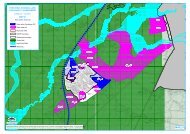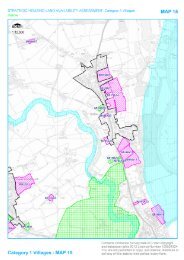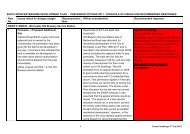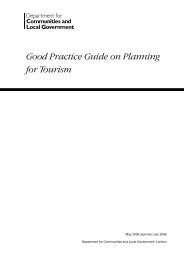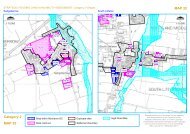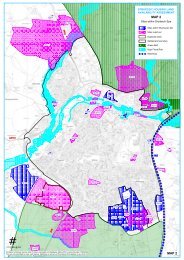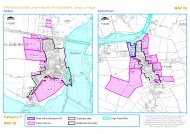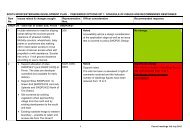Strategic Flood Risk Assessment - South Worcestershire ...
Strategic Flood Risk Assessment - South Worcestershire ...
Strategic Flood Risk Assessment - South Worcestershire ...
You also want an ePaper? Increase the reach of your titles
YUMPU automatically turns print PDFs into web optimized ePapers that Google loves.
8.7.3 Raised DefencesConstruction of raised floodwalls or embankments to protect new development is not a preferredoption, as a residual risk of flooding will remain. Compensatory storage must be provided whereraised defences remove storage from the floodplain.Temporary or demountable defences are not acceptable flood protection for a new developmentunless flood risk is residual only.8.7.4 Developer ContributionsIn some cases and following the application of the sequential test, it may be necessary for thedeveloper to make a contribution to the improvement of flood defence provision that wouldbenefit both the development in question and the local community. Developer contributions canalso be made to maintenance and provision of flood risk management assets, flood warning andthe reduction of surface water flooding (i.e. SUDS).Defra’s <strong>Flood</strong> Defence Grant in Aid (FDGiA) 14 goes to flood risk management authorities to payfor a range of activities including flood defence schemes that help reduce the risk of flooding andcoastal erosion. Some schemes are only partly funded by FDGiA and therefore any shortfall infunds will need to be found from elsewhere using Partnership Funding, for example local levyfunding, local businesses or other parties benefitting from the scheme.If a developer relies on a project to improve an existing defence, the developer will be expectedto make a contribution which should be in proportion to the benefits received by thedevelopment. For new development in locations without existing defences, or wheredevelopment is the only beneficiary, the full costs of appropriate risk management measures forthe life of the assets proposed must be funded by the developer.However, just because the developer is willing to fund the cost of the necessary protection fromflooding or coastal erosion, does not mean the development can be made appropriate; otherpolicy aims also need to be met. Funding from developers should be explored prior to thegranting of planning permission and in partnership with the local planning authority.8.7.5 Building DesignInternal areas of new development should be designed to be dry during the 1 in 1000-year floodevent.The raising of floor levels within a development avoids damage occurring to the interior,furnishings and electrics in times of flood. If it has been agreed with the Environment Agencythat, in a particular instance, the raising of floor levels is acceptable, they should be raised to600mm above the maximum water level caused by a 1 in 100-year (1% AEP) event plus climatechange. This additional height that the floor level is raised to is referred to as the “freeboard”.Allocating the ground floor of a building for less vulnerable use is an effective way of raisingliving space above flood levels.Putting a building on stilts is not considered an acceptable means of flood mitigation for newdevelopment. However it may be allowed in special circumstances if it replaces an existing solidbuilding, as it can improve flood flow routes. In these cases attention should always be paid tosafe access and egress and a legal agreement should be entered into to ensure the ground flooruse is not changed.8.7.6 Resistance and ResilienceThere may be instances where flood risk remains to a development. For example, where theuse is water compatible, where an existing building is being changed, where residual riskremains behind defences, or where floor levels have been raised but there is still a risk at the0.1% annual probability. In these cases (and for existing development in the floodplain),additional measures can be put in place to reduce damage in a flood and increase the speed ofrecovery. These measures should not be relied on as the only mitigation method.14 Principles for implementing flood and coastal resilience funding partnerships (Environment Agency, 2012)2012s5947 S <strong>Worcestershire</strong> Level 2 SFRA Update FINAL Report v1.0.doc 177




